Hypoaspis miles
Beneficial Predatory Mites -
Hypoaspis miles (Stratiolaelaps miles) and others...
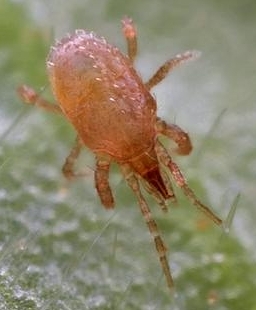 Picture courtesy of Krister Hall
Picture courtesy of Krister Hall
This guide focusses primarily upon Hypoaspis miles but should serve as a reasonable usage guide for most of the other species of predatory mite mentioned.
Hypoaspis miles are a light brown/tan species of soil-dwelling, predatory mite, less than 1 mm. in size used predominantly in organic gardening. Although touted as a Sciarid fly control, they are actually voracious predators, inhabiting the top few centimetres of soil and feeding on any small bugs, insects and mites, including all stages of springtails and even nematodes.
They are adept hunters, fast-moving over substrate surfaces, able to climb over various obstacles and consume perhaps 5 prey items per day. It appears they will tackle anything of similar size to themselves and possibly even a little larger. They are also scavengers and can feed on soil debris and vegetable matter in the absence of suitable prey.
Hypoaspis will eat tackle many of the pests we see in snail tanks such as Riccardoella mites, springtails, small fly larvae and any nematodes in the top layer of the soil but they are completely harmless to larger creatures like snails. This, coupled with their ideal environment of warmth and humidity make them the perfect solution, particularly because snails are so sensitive to chemicals so they are not an option for an owner. I have personally witnessed Hypoaspis entering the pneumostome in search of food, where Riccardoella mites are known to congregate. This is probably the biggest factor in the use of these mites as they will search and find them wherever they hide, which just isn't possible with conventional methods.
Hypoaspis will not become a pest in their own right because their population fluctuates with their prey and they are harmless to children and pets. They tolerate a variety of conditions, except flooding but are inactive below 8° C.
Life-cycle
| 15°C | 25°C | 30°C | ||
| Juvenile development time | 46 | 10 | days | |
| Juvenile mortality | 52 | 3 | 24 | percent |
| Female laying (Daily Mean) | 0.4 | 2.3 | 1.3 | eggs |
| Female longevity | 90 | 34 | days | |
| Oviposition period | 58 | 25 | days |
Hypoaspis eggs hatch in 2 to 3 days into young nymphs and take 10-12 days to develop at optimum temperatures. Colonies have shown to be female-biased at all temperatures, peaking between 25-29°C. Female longevity is significantly shorter than for males. 1
Under magnification, most stages of Hypoaspis look and act very similar, with young ones being paler. Young Hypoaspis are as voracious as adults.
Hypoaspis populations fluctuate with the availability of food but can be sustained in a tank environment for months on end if you do not throw too much of the soil away.
Usage Instructions
Hypoaspis are usually supplied in a pasteurised peat/bran mixture or vermiculite in a dispenser container, usually in quantities of 10-25,000.
It's worth mentioning at this point that they may also be supplied with another species of mite as a food source for the predators. Further research shows that this is usually a mold-mite, perhaps Tyrophagus putrescentiae. The mites page details this species as a potential candidate for an as yet unidentified mite/tick that has been found in the faeces of snails imported from West Africa though it is unknown whether they arrived with the snail or were picked up along the way to the eventual owner. In any case, they spread to other snails. Tyrophagus are known to be able to inhabit bowels, and look very similar.
Since discovering Tyrophagus mites may be supplied as feeder mites, I have doubts if they are the same species but in my opinion it is worth getting ones without just in case.
Defenders who supply Hypoaspis have confirmed via telephone that theirs do not contain feeder mites. I have used these and looked under magnification so I can verify that is the case as far as I can tell. To check for feeder mites, inspect under x10-x15 magnification. The predators are brown/tan and move quickly, whereas in contrast the feeder mites would be white/translucent and move slowly.
Hypoaspis should be released immediately upon arrival. Do not refrigerate them. Moisten the substrate or target area at least 10 minutes prior to release and wait a couple of hours afterwards before any heavy spraying.
Most containers include a shaker lid which allows for distribution over the soil surface. Hypoaspis move extremely well over most substrates, so it is unnecessary to apply to all surfaces. You may wish to leave the container in the tank until any stragglers have left.
In my experience, the mites won't survive much longer than perhaps 7-10 days in the container, long enough to be able to share them with other owners but not long enough to store for future outbreaks. It may be possible to increase this as the medium they come in is usually very dry and they like humid conditions. A light spraying inside the tub may increase their survival chances. If you are not re-posting them I would recommend putting any unused ones in a proper container of their own, with damp soil and vegetable matter. I have more suggestions for long term use without re-buying below.
Hypoaspis will not survive below the top few centimetres of substrate so it's important that you don't disturb the soil too vigorously during the treatment period.
There is some mention of not applying Hypoaspis to soil that has been treated with lime but I am assuming this is caustic, gardeners lime rather than calcium-enriched substrate like snail owners often used as I have certainly never experienced any problems relating to this.
Strategy & Considerations
There are two way to use Hypoaspis, as a curative or a preventative.
As a Curative
This is the most likely reason for purchasing these mites, and usually to sort out a Riccardoella problem. As with any biological control, in normal circumstances they are never 100% effective, they simply keep the numbers down. This state of equilibrium will eventually occur in our tanks as the number of predator mites dwindles through lack of prey. So to use as a curative we must bombard the prey item. I suggest the following regimen:
- Empty your tanks and throw away any substrate.
- Clean and rinse everything thoroughly.
- Replace with a thin layer of fresh, sterilised (or dehydrated) substrate. A thin layer helps to ensure the mites don't get buried which would kill them and makes it easier for them to find their prey. It also means they can get to any nematodes, particularly so any still on the body of the snail cannot escape their reach.
- Only put minimal ornaments in, to try and keep nooks and crannies to a minimum.
- Bathe the snails thoroughly.
- Add thousands of mites to the tank. Note: I've been asked if this amount was irritable to the snails in any way but I didn't notice any problems or reactions at all. Also, given the alternative of being predated on, there's simply no contest, particularly as it can succeed as a "once-only" treatment.
The idea behind this is to swamp the tank with thousands of mites all looking for the few remaining Riccardoella. The Hypoaspis will be forced to find them, and find them they certainly will. The chances of any Riccardoella being missed are very small and the assault on their population will slow down their reproductive capacity. With only a few Hypoaspis, they'd be reproducing as fast as they are being eaten.
It's worth noting that Riccardoella are able to swim quickly across water. I have observed this when trying to clean them off snails. Conversely, Hypoaspis don't like open water so it's probably worth withholding a water dish for the duration of this process.
I did this once with Riccardoella and they have never returned so it has been a 100% success for me, and for other people. Look through the pests, disease and illness section of the forum for more testimonials.
As a Preventative
Hypoaspis live for a few months and their numbers will expand with need so lighter dosages can be used as a preventative. Certainly in my experience, the presence of Hypoaspis did keep the numbers of other tank life down over a period of time.
Frequently Asked Questions
Are there any risk to other tank inhabitants, such as woodlice?
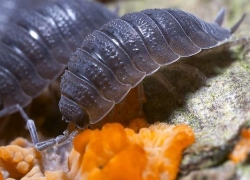 Picture courtesy of Krister Hall
Picture courtesy of Krister Hall
There have been lab tests to see if they are effective against woodlice:
"Currently under investigation is the potential for these mites to impact root mealybugs (Rhizoecus arabicus and other Pseudococcidae family members), sow bugs and pill bugs, a.k.a. rolly-pollies (Portcellio spp. and Armadillidium vulgare, respectively), and even a fungus-eating mite. The control of sow bugs looks like it's a lab thing only unfortunately. I've yet to hear positive feedback from the field." 2
Personally I think adult woodlice are not under threat because of their size but juveniles are. Size, speed and accessibility are all factors. If Hypoaspis can catch something that isn't too much larger than themselves, they'll eat it.
If woodlice are important to your tank habitat, I'd recommend removing them temporarily if you wish to use Hypoaspis as a curative or simply keep adults only.
Is it possible to buy them by the hundreds rather than thousands?
Not that I have found. I did make some enquiries with a few companies to try to convince them to break them down into small tubs for reptile and invertebrate owners but they get them from a larger manufacturer because they're for organic gardening on a reasonably large scale.
Is it possible to buy them in a storable form, such as dormant eggs?
Not that I am aware of. I have tried to find out how they are cultivated and if this is possible but so far I haven't found anything.
How effective are they against Nematodes?
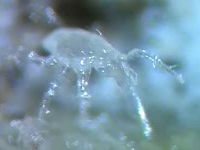 Picture courtesy of science.ceh.ac.uk
Picture courtesy of science.ceh.ac.uk
I've seen videos of a different species of Hypoaspis called Hypoaspis aculeifer eating nematodes and I have been informed that Hypoaspis miles will also eat nematodes.
I haven't observed it myself but after putting thousands in my tanks, the worm problem has been reduced but... I did take some other steps like removing food quicker and more ventilation so I can't say for certain how much they helped. See the nematode page for more information.
The problem is that they can only get at the nematodes in the top layer of soil, so they will never get them all. However, they will pick the snails clean and nematodes get trapped in the mucus of the snail, so a thin layer of substrate will give the worms a much worse chance of escaping them.
Can Hypoaspis eat [insert name of bug]?
If they exist in the top layer of soil or above ground, are not too much bigger than Hypoaspis and can be caught, I imagine they'll be eaten.
I've found some mites, could they be Hypoaspis?
There are thousands of species of mite so it's impossible to know from looks alone. They'd probably have to inspected at x50-x500 to be differentiated by an expert. But if you have mites that look very similar there are some steps you could take to see if they are beneficial or problematic.
I'd suggest you take or send some to your local council pest department. My local council offer that service and as far as I know they'll do it for free.
Or, if you want an easier way to be sure, here is a suggestion. Find a wild slug that has mites, the larger the better. This shouldn't be hard, they usually have a few and sometimes they are crawling with them. Gently tapping the mantle or pneumostome of the slug will cause the Riccardoella to scatter.
I originally suggested keeping the slug but I've found that slug slime is much more viscous and sticky than snail slime and Hypoaspis struggle to move across it. I'm not suggesting slug owners abandon the idea, but for the purposes of a test it's better to use the corner of a piece of paper to flick the Riccardoella mites into a container.
Add your unknown mites and give it 24 hours and then check. If the small, harmful mites have disappeared then your larger, brown/tan mites have eaten them and in that case I'm 99% sure they pose no risk to the snails and in fact are extremely beneficial.
If they did turn out to be Hypoaspis, or other predator mites for that matter, who knows how you ended up with them. Mites seem to get around, maybe on plants or food. I know some species such as spider mites can travel on air currents! People with plants may have come across those so they'll know they can just get in somehow.
Will they stay in the tank?
It is possible one or two could escape, but they wouldn't survive very long because of how dry it is in houses, plus they're almost too small to notice. But think of it this way, while they survived they'd hunt out bugs in your house. You should try to think of them as your snails' best friends!
Long-term use: Keeping your own colony
One of the main problems with Hypoaspis is the quantity you have to buy. Obviously you can buy between a few owners but being able to maintain a colony would be desirable for many people. I have a solution:
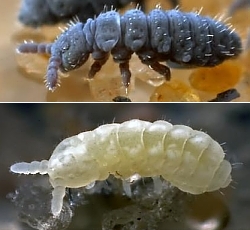 Picture courtesy of Krister Hall
Picture courtesy of Krister Hall
The trick is to breed food for them without having to bring in pest-ridden soil from outdoors which could result in unwanted pests in the tank when you do decide to use them. We need a harmless prey item, that is easy to breed in a tank that Hypoaspis will eat. The answer is Springtails, members of the genus Collembola.
Collembola, like damp conditions and they are very prolific breeders. They feed on rotting fruit and vegetables and you will probably have encountered them in your tanks at sometime or other. They are easy to identify. They are tiny but they can jump quite far, hence the common name Springtails and they inhabit virtually any patch of soil you can find.
The idea is to keep two extra tanks, one for breeding Collembola as food for the Hypoaspis and one for keeping the Hypoaspis. This separation ensures your Collembola population doesn't get wiped out. Simply place slices of fruit in your Collembola tub, keep the conditions damp and watch them multiply.
You can transfer some of the Collembola to your Hypoaspis tub on a slice of fruit, as long as you are careful not to disturb them. I tried this as a short experiment and I'm pleased to announce the Collembola were eaten, making this idea workable.
You can introduce soil containing Hypoaspis into your snail tanks, knowing that any Collembola that get transferred accidentally will be safe for your snails and will be finished off by the Hypoaspis anyway.
Where to buy
defenders.co.ukbiowise-biocontrol.co.uk
aquaculture-hydroponics.co.uk
interiorlandscaping.co.uk
just-green.com
ladybirdplantcare.co.uk
syngenta-bioline.co.uk
Alternatives
Here are some possible alternatives to Hypoaspis miles:
Hypoaspis aculeifer
A very close cousin of Hypoaspis miles, these mites tolerate the same conditions and should be as effective. They actually prefer 18-23°C rather than Hypoaspis miles' 15-30°C., perhaps making them more suitable for certain tank situations. The videos of Hypoaspis I link to in this page feature these.
They can be bought from interiorlandscaping.co.uk.
Neoseiulus cucumeris (Amblyseius Cucumeris)
Feeding mainly on thrip larvae, this species is known to tackle other mites, so they may be useful against Riccardoella. Also, they like humidity, making our tanks an ideal environment for them. In terms of our need their effectiveness is unknown as far as I am aware, I haven't tried them and I've never heard any reports. I have only found a few suppliers that sell to the general public:
defenders.co.ukaquaculture-hydroponics.co.uk
just-green.com
interiorlandscaping.co.uk sell these and a very close cousin Neoseiulus californicus (Amblyseius californicus).
Iphiseius degenerans (Amblyseius degenerans)
Another predator mite that enjoys high humidity and therefore suitable for tank use. They are voracious, living for 40 days or so and can become well established for use as a preventative. Their efficacy for our needs is unknown. It is worth noting they will eat other predator mites, so they couldn't be used in conjunction with other species.
I have yet to find a UK supplier that will sell to the general public.
Atheta coriaria
Believed to originate in Europe, Atheta coriara is a predatory beetle that has specialised in feeding on soil-dwelling larvae of small Diptera species. Although it preys primarily upon Sciarid larvae and eggs, other insects may be taken. The adults are 3-4 mm. in length and are brown/black in colour. The larvae are thin and a pale yellowish white, darkening slightly in the later larval stages. It is a predator at every stage of its development. These beetles are tolerant of a wide range of temperature, humidity, light, and soil conditions. These beetles can fly, and whilst they are likely to hang around where food is available, this possibly makes them unsuitable. However, that's really down to the individual who has to handle them.
References
- Entomologia Experimentalis et Applicataline), Volume 85, Number 2 / November, 1997, Pages 177-187 (http://www.springerlink.com/content/w082722105863724/ - link now dead)
- http://www.greenmethods.com/incl_pages/gb_Hypoaspis.php
A special mention must be given of the photographs of Krister Hall. If you want to see the most stunning macro shots of small life I have ever witnessed, then click here. You'll not be disappointed.

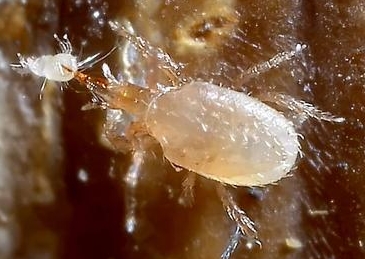 Hypoaspis miles eating a mold mite
Hypoaspis miles eating a mold mite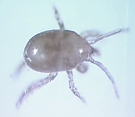 Picture courtesy of
Picture courtesy of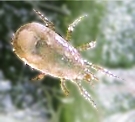 Source picture courtesy of
Source picture courtesy of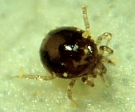 Source picture courtesy of
Source picture courtesy of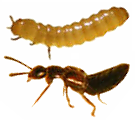 Source pictures courtesy of
Source pictures courtesy of